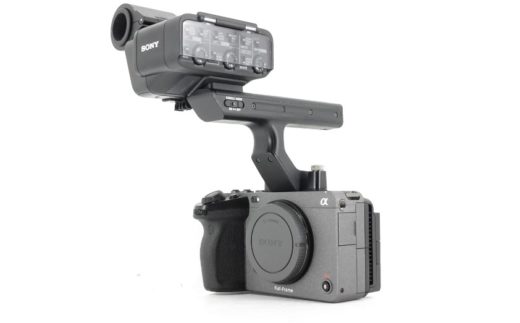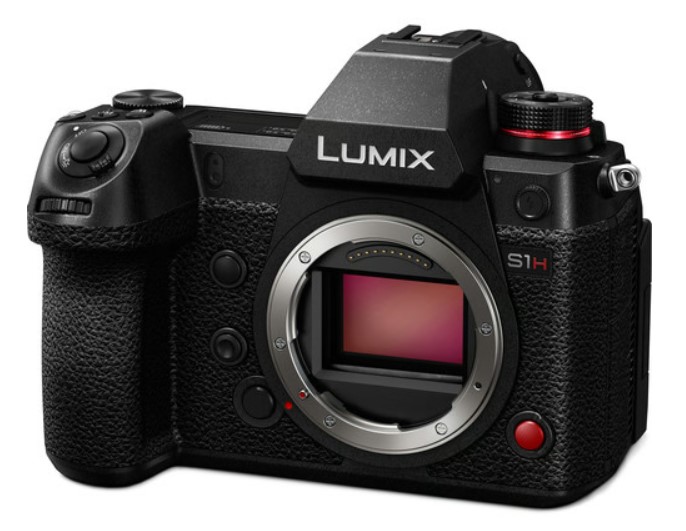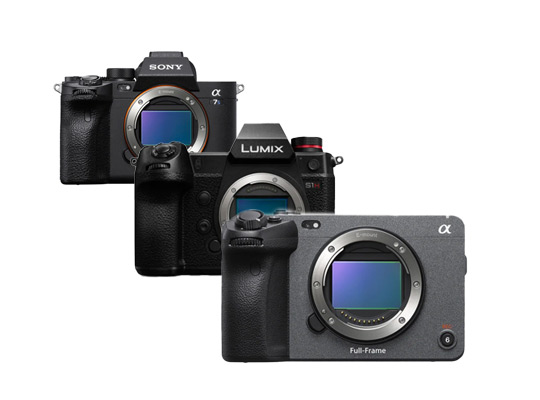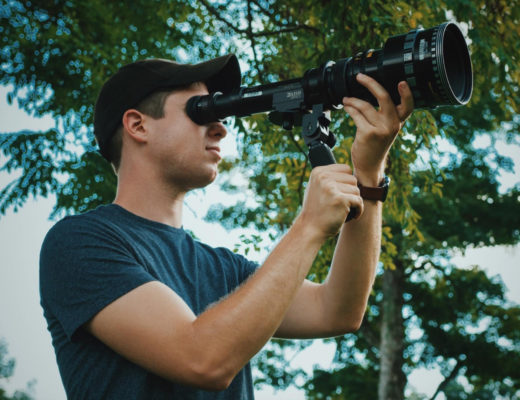Having recently covered the best cameras for video under $2500, it is clear quite how far manufacturers have come in producing great video at affordable price points. I thought it would be interesting to cover the next price bracket up – looking at the best options and why you would spend the extra money.
Probably the most obvious difference here is that these cameras are all full frame, whereas most in the lower bracket top tier are Super 35. There are full frame cameras in the sub $2500 bracket, but for me they compromise in too many areas. At this price point you get full frame without those compromises. The hybrids here are very much video first and designed to be workhorses, without the overheating issues that can limit you on longer shoots.
My top tier – Sony and Panasonic
This time I have only three top tier cameras – the Sony A7SIII ($3500), the Sony FX3 ($3900) and the Panasonic Lumix S1H ($4000, often $3700). I think these cameras are set apart by their excellent dynamic range, image quality, video features and reliability. Added to this is the fact that both the Sony E mount and the Panasonic/Leica L mount both support more affordable third party lenses from the likes of Sigma, Tamron, Rokinon, Samyang, etc. – something Canon no longer offer.
Again a handy spreadsheet of some of the key data:

Notes:
- Pricing – is rounded to the nearest 5 to be more clear and avoid marketing
- Resolution – approximate – I am not worrying about C4K vs UHD here but it may be important to you – see manufacturer’s sites for full specs – usually the top spec involves a crop or limited functionality, plus they all can do more externally
- Dynamic range & Rolling shutter – taken from the excellent lab tests at Cine D or Gerald Undone – I’m using the more realistic 2:1 signal to noise ratio figure (so it will be lower than what is quoted by the manufacturer). Note that about 2 years ago Gerald Undone adjusted his method to align with Gunther’s at CineD, so I’m only using those recent figures
- IBIS – In body image stabilization – useful for handheld shooting and vintage glass, but sometimes taken out of higher end cameras
- TC – Timecode – the ability to jam sync timecode from a device like a Tentacle Sync (if you don’t have this, you can still record LTC onto an audio track which Davinci Resolve can read)
- ND – Built in ND filters
- Year – year of release
What are the key considerations?
- Do you need a hybrid? My rules is: if you need a hybrid, buy a hybrid, if you don’t, just get the best camera for your needs whether it is one or not – but bearing in mind that a hybrid can overheat as it usually doesn’t have active cooling. That said, at this price point the hybrids from Sony and Panasonic do much better.
- Will your older lenses fit? Most older lenses can be adapted to most mirrorless cameras, but you should check out the available adaptors from the likes of Metabones, Sigma or from each camera manufacturer.
- Will your newer lenses fit? Newer lenses from the mirrorless ranges can’t be adapted – for example Canon RF, Sony E, Nikon Z, Fujifilm X or M4/3 – so choose carefully before you buy into an ecosystem.
- Continuous autofocus for older lenses? If this is something you use, it doesn’t tend to work across brands via adaptors, for example Canon EF lenses on a Sony.
- Full frame or Super 35? This is a case of pros and cons – full frame means shallower depth of field which many want, but more expensive, larger lenses and less use of vintage glass. That said most full frames can be put into crop mode when you need it. Super 35 / APS-C gives you a crop factor which you need to allow for, but it might suit you if shooting far away subjects.
- 6K or 4K? If you’re delivering 4K/UHD, it is a bonus to shoot more than that and have the leeway to crop in or stabilize, but it may not be a deal breaker for you.
- Cards – I haven’t covered that particularly as I don’t think it swings things that much, unless you happen to have a good collection of say CFast or CFexpress, then you might want a camera that takes what you have. Though you can just shoot on a good SD card on any of them if you’re happy with H.264.
- Extra features? There are many other features that may or may not be important to you – I will cover key ones below
1. Sony A7SIII

The first two options – the Sony A7SIII ($3500) and the Sony FX3 ($3900) – are essentially the same camera internally, with the same sensor and processor and perform the same in most key metrics. So first I’ll cover what is common to both. Both have excellent dynamic range, one of the lowest rolling shutter times of any small camera & the full frame aesthetic. They have excellent low light / high ISO performance due to the lower megapixel dual gain sensor. They have the fantastic and very customizable autofocus, great IBIS, 10-bit 4:2:2 internal recording, full size HDMI out & USB power delivery. They shoot 4K120 with a slight crop and full frame from 4K60. Both are fantastic cameras.
So really the key difference is that the A7SIII is a hybrid – for sure it’s video-first (thus the letter S as opposed to R for the photo-first cameras), but it can still take great photos as long as you don’t need a very high megapixel count. If you want a hybrid that is photo first, but still has great video capabilities, the Sony A7R V ($3900) is a great option with its 61MP sensor and it even has some things that are better than the A7SIII for video, due to it being a newer camera. It has a brilliant tilt & flip screen, 8K recording if you needed it & some smarter autofocus options. There are some compromises on the video front, though, with various crop modes in play, worse rolling shutter, dynamic range that’s a bit lower & worse low light performance.
2. Sony FX3

The Sony FX3 ($3900) comes in at $400 more, but comes with the XLR top handle which is well designed. If you find it a bit short, it can be extended nicely with the Kondor Blue extension kit ($45). While you can get a $600 XLR adaptor for the A7SIII, it’s not as secure and there’s no handle.
The FX3 is part of Sony’s cinema line like its younger and much cheaper Super 35 sibling the FX30 ($1800). Aside from that being partly marketing (as I mentioned, it’s the same internally as the A7SIII), that means quite a few useful video additions. It has the active cooling fan (which you can have blow faster when not shooting and slow down to keep noise levels lower while filming). However the A7SIII solved pretty much all of the overheating issues that dogged the A7SII, so this isn’t as important as it could have been, but still this does make it more robust. While it does away with the EVF, it adds a bunch of useful 1/4″ threads, better buttons and tally lights as well as better firmware. That means you have access to things like Cine EI mode, user LUTS, ability to jam sync timecode and a better video menu which is very welcome. These extra video features helped it get Netflix approved, pretty impressive for a camera of this size.
3. Panasonic Lumix S1H
 The Panasonic Lumix S1H ($4000) is a very similar camera to the A7SIII in many ways. It is a video first hybrid (thus the H), though it has a 24MP sensor rather than 12MP, which may suit some hybrid users better. However that means the low light performance isn’t quite as good. It has pretty similar specs to the cameras above so I’ll dive into some of the differences. It has even higher dynamic range and beautiful highlight roll off. Colour-wise, for me it’s slightly harder to grade, but that’s quite subjective. The rolling shutter is not as good, the IBIS is good, but can be warpy and there are less lenses available. It has better cooling with the active cooling fan & a more useful & higher resolution tilt/flip screen. Like the FX3, but unlike the A7SIII, it’s Netflix approved – and has the advantage of recording C4K internally, with the Sonys limited to UHD. With an external recorder like the Atomos Ninja V it can record 10 bit 4:2:2 C4K60 or RAW 12-bit 5.9K/30, with BRAW (my favourite of the RAW codecs) having been added in a firmware update.
The Panasonic Lumix S1H ($4000) is a very similar camera to the A7SIII in many ways. It is a video first hybrid (thus the H), though it has a 24MP sensor rather than 12MP, which may suit some hybrid users better. However that means the low light performance isn’t quite as good. It has pretty similar specs to the cameras above so I’ll dive into some of the differences. It has even higher dynamic range and beautiful highlight roll off. Colour-wise, for me it’s slightly harder to grade, but that’s quite subjective. The rolling shutter is not as good, the IBIS is good, but can be warpy and there are less lenses available. It has better cooling with the active cooling fan & a more useful & higher resolution tilt/flip screen. Like the FX3, but unlike the A7SIII, it’s Netflix approved – and has the advantage of recording C4K internally, with the Sonys limited to UHD. With an external recorder like the Atomos Ninja V it can record 10 bit 4:2:2 C4K60 or RAW 12-bit 5.9K/30, with BRAW (my favourite of the RAW codecs) having been added in a firmware update.
The S1H has the advantage of shooting 6K (well 5.9K) 3:2, which is great for anamorphics or when shooting for social, so that when you do your square or vertical versions you can make the framing less tight really easily. I’ve done this with the Arri classic’s 4:3 shooting mode and it works really well.
One of the main downsides is the autofocus – it lacks phase detect and it is significantly worse at tracking than the Sony or Canon offerings, but this may not be something you plan on using. Another big issue is its age – it was released in 2019 and so will not hold its second hand value as well. And we’ve seen that the IBIS and AF were vastly improved in the S5 II over the S5, so I’d expect the same in the S1H II which I’d expect by the end of the year. Still, it remains an excellent camera.
Best of the rest
Canon EOS R5
The Canon EOS R5 ($3900, $3500 during March) is the main camera that really should be in the list above. It can produce some stunning video for sure and could be a great option for those with RF lenses. There are two major issues with it – poor dynamic range and overheating. CineD measured the dynamic range significantly lower than its competition above. It was released with a fanfare about its 8K, but people soon released it just couldn’t be used for any serious video work due to overheating and slow recovery. That said, in July 2022 with firmware 1.6, Canon managed to mostly solve this, adding in a setting that Sony cameras have to allow the camera to build up more heat, but still, how hot do you want your camera or cards to get.
Both of these issues were fixed with the Canon EOS R5C ($4800, $4400 during March), with its active cooling fan and greater dynamic range, making it a much better choice for video shooters, but at $1300 more than the A7SIII that is a hard sell. Still for RF lens owners and even EF owners (with the video AF compatibility) it is a great camera.
But the problem is, at that price, you start looking at the Canon EOS C70 ($5500) which I personally think shoots much nicer video, though it is Super 35. But by then you’re pretty close to the next price bracket which includes the Sony FX6 ($6000), RED Komodo 6K ($6000) and Blackmagic URSA Mini Pro 4.6K ($6000) and more. So I find Canon’s prices too high to recommend them. The thing is, Canon are selling their cameras like hotcakes, including the video focused ones – even issuing an apology for their lack of stock, so there clearly is demand. I would guess though that this is primarily from the photography crowd who are increasingly being asked to provide some video in their work.
Blackmagic Pocket 6K Pro
The Blackmagic Pocket 6K Pro ($2535) for me still competes here even with its lower price and will rival the cameras above if you are happy with the EF mount, lack of autofocus and other factors which you can read in my write up here.
Canon C200
I have to mention the Canon EOS C200 ($3500) due to its hefty price drop (I assume to clear final stock as it’s close to end of line) – it was originally $6500 when it came out in 2017. It’s a pretty nice camera and could impress your clients to look at, but there is a distinct lack of good codec options – only the tricky to use Cinema RAW Light (fills cards fast / hard on your computer) or 8 bit 4:2:0 and I think that should be left behind in the 2010’s (hey Facebook, why is there banding in my sky?)
Nikon Z7 II
Nikon again are not really competing on the video front at the moment, but that doesn’t mean you can’t get great results out of the Nikon Z7 II ($3000), especially for those with Nikon Z mount lenses. It’s a full frame hybrid with a 46MP sensor, IBIS and records up to 4K60 with a very small crop, but is severely lacking in only recording 4:2:0 8 bit internally and with the nasty 30 minute limit. It actually has poorer video quality than its younger sibling the Z6 II ($2000), so it is more geared to photographers who need that extra megapixel count. Like the Z6 II, it can record 4:2:2 10 bit externally, so it’s worth factoring in an external recorder into the price if you’re serious about using it for filming.
Any other options?
There are some good box cameras in this price range, from Kinefinity, Z CAM, Panasonic & Bosma, but the real price once kitted out fully will be much higher which is why I haven’t included them as proper contenders.
This sub $4000 price bracket is slightly more confusing due to both the A7SIII and the S1H being a bit old and because the lower price bracket of sub $2500 is so strong. Many will be ok with the Sony A7 IV ($2500) or the Panasonic S1 ($2500) for example if they need full frame. But the cameras at this higher price point are workhorses designed for the professional video shooter and that will suit many who need the smaller form factor or who don’t have the budget for the next step up.

Filmtools
Filmmakers go-to destination for pre-production, production & post production equipment!
Shop Now













